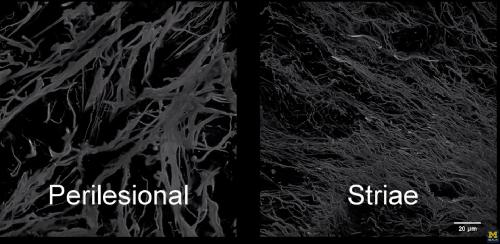Don't believe the hype when you see claims about creams and ointments that promise to prevent or reduce pregnancy stretch marks.
The line-shaped lesions also known as striae gravidarum affect 50 percent to 90 percent of women. However, some women are at higher risk than others, due to factors like family history, how much weight they gain in pregnancy, whether it's a single or multiple birth and whether they've had stretch marks before for another reason like obesity. Though not everything is known about what causes stretch marks, is it known that skin stretching is not the only risk factor.
A new study investigated what could be causing stretch marks at the molecular level, a field that hasn't received much research attention because they're not viewed as medically dangerous.

"Most of the existing products aren't based on solid scientific research," said Frank Wang, M.D., assistant professor and dermatologist at the University of Michigan Health System. "Very few to none of the items touted to prevent or fix stretch marks really work. Because stretch marks may compound the stress of new motherhood for many women, it's important to learn more about them. Some women feel like their self-esteem, quality of life and willingness to engage in certain activities are affected."
Researchers studied skin samples from 27 pregnant women who had recently-formed stretch marks, comparing the stretch mark skin to both nearby stretched skin on the abdomen and to less-stretched skin on the hip.
Wang and his colleagues found the elastic fiber network in the dermis gets disrupted in a stretch mark. After giving birth, this network remains disrupted. Elastic fibers give skin its elasticity, or the ability to "snap back," after stretching. The skin tries to repair the disrupted elastic network but it does not appear to be effective, which in turn promotes the lax, loose skin seen in more mature stretch marks.
Unfortunately, present research of topical treatment options doesn't find anything currently available to effectively repair those disrupted elastic fibers.
"It may, therefore, make more sense to focus on preserving the elastic fibers you have rather than repairing damaged ones within stretch marks," Wang said. "Regardless, it's more complicated than just rubbing something on your stomach."
Looking forward, Wang is already continuing his research with the end goal of helping pregnant women prevent or effectively improve the appearance of stretch marks. Another study in the works examines changes in collagen in stretch marks. Collagen is what gives skin its strength and support.
Wang's team is also studying changes in more established stretch marks that have become less visible, and finishing a survey study of about 200 pregnant women to learn more about the effect on quality of life.
The authors see the potential for expanding this knowledge to other reasons people get stretch marks, such as obesity, growth spurts or steroid usage.




Comments